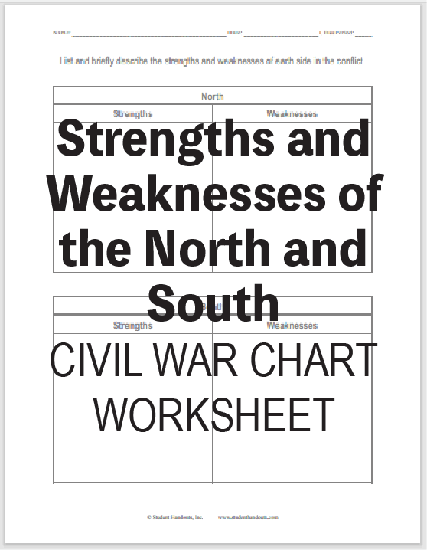The chart worksheet asks students to briefly list and describe the strengths and weaknesses of the United States and the Confederacy during the American Civil War (1861-1865).
Click here to print. Answers will vary.
The strengths and weaknesses of the North and South in the U.S. Civil War played a crucial role in shaping the course and outcome of the conflict.
Strengths of the North (Union):
- Population: The North had a significantly larger population than the South. This population advantage provided a larger pool of potential soldiers, laborers, and resources to draw upon during the war.
- Industrialization: The North was more industrialized than the South. It had a well-developed manufacturing sector, which allowed it to produce weapons, ammunition, and other supplies on a larger scale.
- Railroad Network: The North had a more extensive and interconnected railroad network, which facilitated the rapid movement of troops and supplies across long distances.
- Economic Resources: Northern states had greater access to financial resources, including banks, capital, and credit. This enabled the Union to finance its war efforts more effectively.
- Naval Power: The Union had a more formidable navy, which allowed it to establish naval blockades along the Southern coast, disrupting Confederate trade and supply lines.
- Political Leadership: The North benefited from strong political leadership, including President Abraham Lincoln and key generals like Ulysses S. Grant and William T. Sherman.
Weaknesses of the North (Union):
- Military Leadership: The early years of the war saw a series of less effective Union generals, which led to some initial setbacks and high casualties.
- Fighting on Multiple Fronts: The Union had to fight on multiple fronts simultaneously, including the Eastern Theater (e.g., Virginia) and Western Theater (e.g., Tennessee), which strained resources and manpower.
Strengths of the South (Confederacy):
- Military Leadership: The South had several capable military leaders, such as Robert E. Lee and Stonewall Jackson, who often outperformed their Union counterparts on the battlefield.
- Defensive Strategy: The Confederacy adopted a primarily defensive strategy, aiming to protect its territory and wear down the Union's will to fight. This strategy had some initial success.
- Cavalry: The South had a formidable cavalry, led by commanders like J.E.B. Stuart, which provided a mobile and effective force for reconnaissance and raiding.
- Agricultural Resources: The Southern states had a strong agricultural base, producing crops like cotton and tobacco. While this resource could not sustain the war effort in the long run, it provided some economic advantages.
Weaknesses of the South (Confederacy):
- Economic Weakness: The Confederacy faced significant economic challenges. It lacked the industrial capacity of the North, making it heavily reliant on imports for manufactured goods, weapons, and supplies.
- Infrastructure: The South had a less developed transportation infrastructure, including fewer railroads. This hindered the movement of troops and resources.
- Population Disparity: The South had a smaller population, which meant fewer potential soldiers and a smaller labor force for supporting the war effort.
- Blockade: The Union's naval blockade of Southern ports severely restricted Confederate trade and access to essential goods, including weapons and medical supplies.
- Internal Divisions: The Confederacy faced internal divisions, including disagreements between state governments and the Central government in Richmond, which sometimes hindered its ability to coordinate the war effort.
- Limited Foreign Support: The South struggled to gain substantial foreign support, despite efforts to secure recognition and aid from European powers like Britain and France.
Ultimately, these strengths and weaknesses, combined with various other factors, influenced the outcome of the Civil War. While the North had significant advantages in terms of resources and population, the South's military leadership and determination prolonged the conflict. The war's eventual outcome was the result of complex political, economic, and military factors that evolved over the course of the conflict.
|













